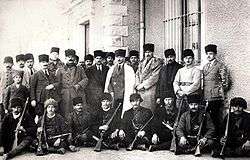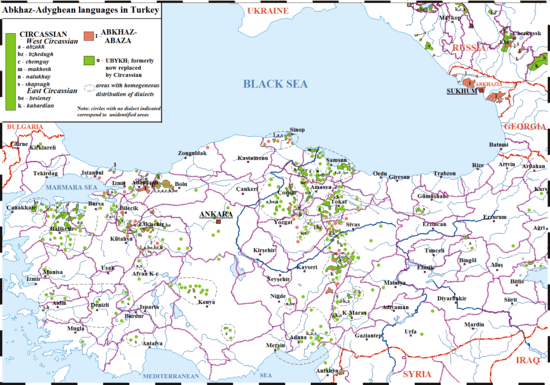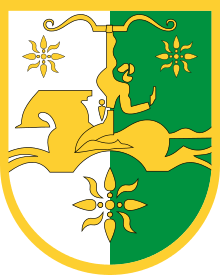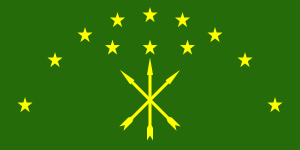Circassians in Turkey
| Total population | |
|---|---|
| 140,000[1][2][3] - 2,000,000[4][5] Estimated 1,000,000[6] – 2,000,000[7][8]–3,000,000[9][10]–5,000,000[7][11] to 7,000,000[12] | |
| Regions with significant populations | |
| Marmara Region, Central Anatolia Region, Black Sea Region | |
| Languages | |
| Circassian, Turkish | |
| Religion | |
| Sunni Islam | |
| Related ethnic groups | |
| Abazins, Abkhazians |

The Circassians in Turkey (East Circassian and West Circassian: Адыгэхэр Тырку, Adyghexer Tyrku; Turkish: Türkiye'deki Çerkesler) are one of the largest ethnic minorities in Turkey, with a population between 130,000 and 2 million. The closely related ethnic groups Abazins (10,000[13]) and Abkhazians (39,000[14]) are also often counted among them. Circassians are a Caucasian immigrant people, but the vast majority of them have assimilated to the Turkish language, and only a small minority still speak their native Circassian languages. The Circassians in Turkey are almost exclusively Sunni Muslims of Hanafi madh'hab.
Demographics
In the census of 1965, 58,339 Turkish citizens spoke Circassian as first language, which was roughly 0.2% of the population. Proportionally, these were most numerous in Kayseri (3.2%), Tokat (1.2%) and Kahramanmaraş (1.0). Another 48,621 citizens spoke Circassian as second language.

See also
References
- ↑ Milliyet, Anadil kontrolüyle sağlanan dolaylı bilgininde katılmasıyla ortaya çıkan tabloda Türkiye'de yetişkinlerin (18 yaş ve üstündekilerin) etnik kimliklerin dağılımı ... 0.3 Kafkas kökenli
- ↑ KONDA Research and Consultancy, Social Structure Survey 2006
- ↑ Heinz Kloss & Grant McConnel, Linguistic composition of the nations of the world, vol,5, Europe and USSR, Québec, Presses de l'Université Laval, 1984, ISBN 2-7637-7044-4
- ↑ Circassia, Unrepresented Nations and Peoples Organization, archived from the original on 2010-11-29 .
- ↑ Ülkü Bilgin: Azınlık hakları ve Türkiye. Kitap Yayınevi, Istanbul 2007; S. 85. ISBN 975-6051-80-9 (Turkish Language)
- ↑ Dalby, Andrew (2015). Dictionary of Languages: The Definitive Reference to More than 400 Languages. Bloomsbury Publishing. p. 136. ISBN 978-1408102145.
- 1 2 Richmond, Walter (2013). The Circassian Genocide. Rutgers University Press. p. 130. ISBN 978-0813560694.
- ↑ Danver, Steven L. (2015). Native Peoples of the World: An Encyclopedia of Groups, Cultures and Contemporary Issues. Routledge. p. 528. ISBN 978-1317464006.
- ↑ Natho, Kadir I. (2009). Circassian History. Wayne, New Jersey: Xlibris Corporation. p. 505. ISBN 978-1-4415-2389-1.
- ↑ Zhemukhov, Sufian (2008). "Circassian World Responses to the New Challenges" (PDF). PONARS Eurasia Policy Memo No. 54: 2. Retrieved 8 May 2016.
- ↑ Alankuş, Sevda (1999). Taymaz, Erol, ed. Kültürel-Etnik Kimlikler ve Çerkesler. Ankara, Turkey: Kafder Yayınları.
- ↑ Alankuş, Sevda; Taymaz, Erol (2009). "The Formation of a Circassian Diaspora in Turkey". Adyghe (Cherkess) in the 19th Century: Problems of War and Peace. Adygea, Russia: Maikop State Technology University. p. 2. Retrieved 4 May 2016.
Today, the largest communities of Circassians, about 5–7 million, live in Turkey, and about 200,000 Circassians live in the Middle Eastern countries (Jordan, Syria, Egypt, and Israel). The 1960s and 1970s witnessed a new wave of migration from diaspora countries to Europe and the United States. It is estimated that there are now more than 100,000 Circassian living in the European Union countries. The community in Kosovo expatriated to Adygea after the war in 1998.
- ↑ "Ethnologue: Abasinen". Ethnologue. Retrieved 20 November 2014.
- ↑ "Ethnologue: Abchasen". Ethnologue. Retrieved 20 November 2014.
External links
| Wikimedia Commons has media related to Circassian people in Turkey. |

